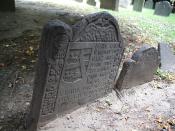Civilization versus the Wilderness in The Scarlet Letter
Recurring throughout The Scarlet Letter, by Nathaniel Hawthorne, is the motif of civilization versus the wilderness. In the story the town of Boston and its surrounding forest represent opposite behavioral systems. The town is one ruled primarily by Puritan ideals. In rule-bound Boston everything one does is on display and transgressions are quickly punished. Conversely, the forest is a safe-haven from the repression of Boston. Society's rules do not apply and human authority does not reign there.
Although the strict Puritan rules in place in Boston are made for the good of the people, it seems that the citizens' morality is clouded by their desire to demonstrate or convince themselves of their own piety as they judge others themselves and love to gossip. In the beginning of the story when Hester Prynne is being exhibited on the scaffold with the scarlet letter "A" pinned to her blouse and her illegitimate child on her hip, the women in the crowd make disparaging remarks and even the children taunt her.
One of the themes of the story is that sin is human nature. Hester becomes almost a scapegoat, her humiliating punishment possibly allows the public to boost themselves mentally, even if only by subconscious, as Hester stand before them in judgment.
Unlike the judgmental town of Boston, The Puritan society rules do not govern what goes on in the forest. The forest is a place of freedom where one does not have to worry about rules. While meeting in secret with Hester, Reverend Dimmesdale proclaims that Chillingworth's vengefulness is a much greater sin than adultery. This bold, heretical statement, though made to a small audience is the first recognition of any sort of alternative to Puritan beliefs. This lack of rules permits greater...


